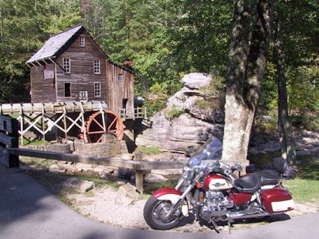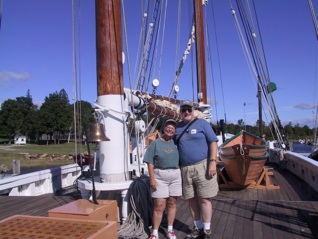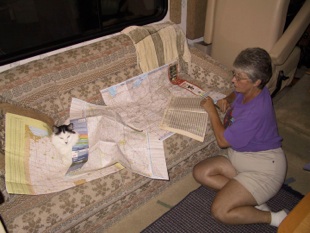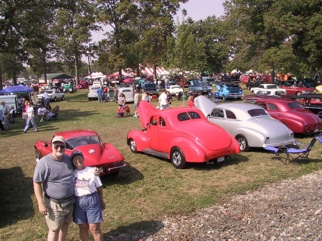October 2002
Almost Heaven...
Maine, New Hampshire, Vermont, New York, Ohio, West Virginia




October 2002
Almost Heaven...
Maine, New Hampshire, Vermont, New York, Ohio, West Virginia
John Denver had it right: West Virginia IS almost heaven.
We’re sitting among beautiful trees, in a campground mostly inhabited by ourselves and a family of six deer, riding beautiful country roads on the motorcycle every day, seeing incredible countryside. West Virginia is a fine place to be this time of year, and we’re delighted to be here. The trees are turning golds and reds all around us. We’ve been told it’s not a good year for fall color, but you sure couldn’t tell it by us! Every turn in the road offers new beauty, and each day we can see more color than the last. The best roads go through leafy glades, with lots of swoopy turns and no traffic; West Virginia has tons of them. We cannot see them all this time through, but we’ll be back next spring. In May, the rhododendrons are in bloom, and we must be here (to paraphrase, oh dear, is it Rupert Brooke?). As near as we can tell, the roads in West Virginia are all not only beautiful, but in wonderfully good condition. Somehow, this small state, which can’t possibly rank high on the overall wealth chart, manages to maintain its roads better than many others. And the state parks are equally nice. We’ve been in four of them so far to look around and they have all been exceptional. Our base of operations for the past six days has been Babcock State Park, near Clifftop, WV. We are in a lovely meadow surrounded by forest. It is a section of the park with twelve or so widely spaced open camp sites, our favorite type. Over the weekend there were two or three others here with us, but since Monday morning, we have had the place to ourselves; oh, and the deer of course.

Our wanderings in this area have taken us to a new town to love: Lewisburg, West Virginia. It’s a charming, prosperous town of about 3500 people, contains a community college, a medical school and wonderful homes from several earlier eras. The town figured in both the Revolutionary and Civil Wars (battle scars still visible on some buildings). The folks were charming and helpful in solving a problem for us, and we will visit them again. The town is in the lovely Greenbrier Valley, which has great bicycling and hiking trails. Check it out! Only a few miles from Lewisburg is the better-known White Sulphur Springs, home of the Greenbrier Resort and Country Club. This is a less interesting town. The resort itself is world famous and impressive, but seems kind of disconnected from the surrounding town which is rather plain and filled with empty store fronts.
The Appalachian range has been our goal ever since leaving Canada over Labor Day, and it has taken us over a month of travel through seven other states to get to this area. But that’s been on purpose and we’ve been having a grand time and great adventures.
We came back across into the United States through a small, remote crossing spot in northern Maine. Earlier in the summer, when we crossed into New Brunswick, it was at the Calais-St. Andrew border, extremely hectic and horribly backed up. UGLY!!!!! We didn’t want to repeat that going the other way, as we had been told the crossing often took several hours. So we found an itty-bitty little crossing and it must have taken us all of 6-7 minutes. We were the only ones there; the guard was kind of bored and came inside to look around for something to do. Well, of course he asked us if we had any citrus, and of course I said we did, so I lost all my oranges and grapefruit I’d been saving for a special occasion. Frump! But he didn’t want the potatoes: “they were on last year’s list, but not this year”; you figure it out!

New Hampshire and Vermont are beautiful, full of grand roads and pretty scenes right out of New England magazines. Vermont remains the most classically perfect state we’ve seen. Even the cows all match each other: they are all Ben-and-Jerry black and white; narry a brown cow to be seen. We visited a grist mill in Littleton, New Hampshire, that was really cool. It was recently reconstructed from a mill that went back to 1800 and is operated as a working mill as well as a store and tourist stop. Bought some stone ground buckwheat pancake mix; pretty yummy stuff. In Vermont we stopped in So. Royalton for lunch one day; this is a great little town that’s claim to fame is that it is the home of the Vermont School of Law. So this nothing-little-place is full of students and coffee houses, in addition to the “normal” New England charm. We liked it a lot. We went there looking for a “Best Places to Eat” spot that had been mentioned in an article we saw. Couldn’t find that spot, but had a nice lunch anyway.
Oh yes, and Jeremy has now had his first (and last, if he has anything to say about it) ride on the motorcycle. He needed to be seen by the vet because of a minor problem, and we didn’t want to move the motorhome. So we put him in the saddlebag of the bike. Boy, did he howl! I kept it partly open as we rode the 10 miles to get to the doc, so he wouldn’t suffocate, and each time I looked back a paw would be sticking out, trying to pry open the top. It was a lonnnnng 10 miles, I’ll tell you! And then of course we had to turn around and ride back. Fortunately, J is a big loving lump of a cat and is blest with a short memory. The thought of repeating the experience with Agnes is enough to make the blood run cold. We’ll keep our fingers crossed.

Moving on, we traveled into New York and down the Hudson River as far as West Point, an interesting experience. Security is tight there, and you no longer can just wander at will, but the museum is excellent and you do go away a believer. We got lost and went in the wrong entrance; the guards were well armed, but incredibly polite --- and incredibly firm about turning us around…..
One neat story we learned at West Point: Eisenhower, shortly after World War I, was part of a group taking a convoy of military trucks to the west coast. The roads around 1920 were really awful, and mostly unpaved. It was at that point that he formed the kernel of the idea that the United States needed a system of unified, good roads connecting all parts of the country. That was the idea that ended up being our interstate highway system. We have mixed feelings about these roads, of course. They have been the death of many, many small towns, and communities have disappeared that once were vital. But the road system does work. You can get from coast to coast on good roads (unless you take the Pennsylvania turnpike!) efficiently. If you want to. We prefer to take the secondary roads, moving more slowly, but being able to get a more local taste as we go along.
A sign we spotted on the side of the road: “If you look like your passport photo, you probably need the trip.”
We were only in New York for a few days; we were off to Ohio for a large rally. We passed through Pennsylvania again (we’re beginning to feel we’ve seen a lot of this state, and that’s just fine with us; Pennsylvania is very pretty and the people are nice; we like the atmosphere here). Strange sign: “Emlenton, Pennsylvania, home of America’s worst apple pie.” Makes you want to stop just to find out, which, of course, is the point!
The rally in Van Wert, Ohio was a revelation. We belong to a group called Escapees, which is a support organization for people who are full-time RVers or spend a lot of time in their coaches and trailers. The rally offered a zillion seminars on technical coach stuff, household hints, travel suggestions, insurance information, etc. etc. We had a great time; well worth the trek across several states to get there. While at the rally, we ran into some buddies from a campground we had stayed at in Florida last winter. They live in Indiana, just south of Fort Wayne, and not far from Van Wert. We accepted their invitation and traveled across the state line to spend a couple of days with them.
These folks have a little piece of paradise. When you think of the mid-west in the fall, you can think of them. They live outside town, among huge trees with falling leaves, beside a small creek, in a sprawling home they’ve added onto over the years. They even have a gazebo with a swing in it! Talk about a quiet, peaceful setting. We rode past fields of corn and soybeans, broken up by clumps of trees and barns. The crops are about to be turned under, and are all gold colored. We saw combines and harvesters everywhere. This area has been hit by the drought along with so many other places, and the corn is badly stunted. It has been a bad year for so many. But everywhere we see homes preparing for Halloween, even though it’s very early. The cornstalks and pumpkins and Indian corn are set out in front of houses, and roadside stands are full of stuff to buy. The only fresh fruit are various kinds of apples. (And apple pies, and apple butter, and, and, and…..yum!) for awhile we followed signs down a country road to the “Haunted Trail of Horror” but then we lost the trail.

The baseball playoffs have begun, leaving Rick in agony most of the time. The Giants are still alive as of this writing, and he is chewing his nails down to the quick. Keep you fingers crossed for us, please. For the first time, we can now listen to the games as we drive along. We recently installed satellite radio in the coach, and are enjoying it very much. Mostly, we enjoy the always clear reception of the commercial free music channels, but we also get ESPN, the Weather Channel, and many more news and information stations for when we want them. The end result is that Rick now tries to drive and listen to hear what Barry Bonds is doing, all at the same time. The other afternoon he missed two highway turns during a particularly tense time. He denies that this happened, but I’m the one who was paying attention to the road at the time. GO YOU GIANTS!
So here we sit in Babcock State Park near Fayetteville, watching the deer, visiting little towns like Sam Black Church and Gauley Bridge, and toasting Robert C. Byrd. He’s the senator from West Virginia who has pushed so hard to develop tourism in his home state. We know why he is so loved here and we salute all he has been able to do. This state needs our tourist dollars, and we’re planning to do our best to help out all we can. We may stay until the snows fly! Besides, we want to go back to check out Jack Horner’s Corner, a not-even-wide-spot-in-the-road around one of yesterday’s bends.
Find a country road and enjoy the fall with us.
Love,
Rick and Kathy
See more photos from 2002-2003

